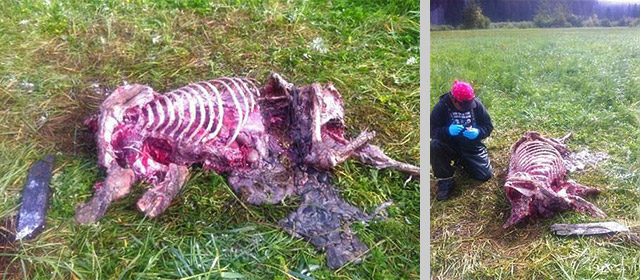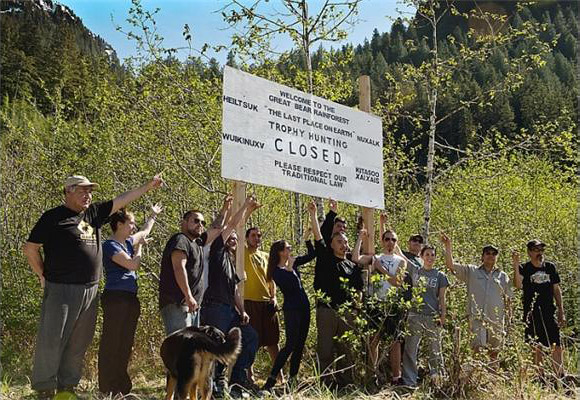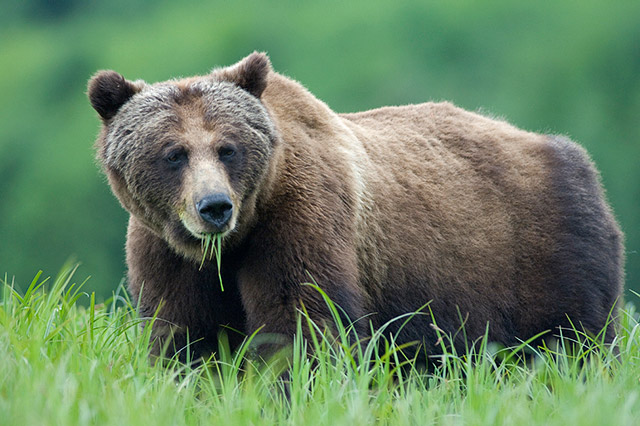|
| |
| 11. September 2013 |
Neuer Film der Coastal First Nations gegen die Trophäenjagd auf Bären.
Die neue Herbstjagdsaison hat begonnen |
| |
| Am 4. September – kurz nach dem Beginn der Herbstjagdsaison auf Bären – haben die Coastal First Nations ihren neuen Film gegen die ethisch höchst verwerfliche Trophäenjagd auf Bären im Great Bear Rainforest der Öffentlichkeit vorgestellt. Der 22-minütige Film mit dem Titel „Bear Witness“ ist ebenso sehenswert wie erschütternd. Er ist über die Website der Raincoast Conservation Foundation unter www.raincoast.org/media/videos/bear-witness oder über die Websites von Pacific Wild oder der Coastal First Nations anzusehen. Der Film zeigt die Umstände, unter denen der Trophäenjäger Clayton Stoner am 26. Mai 2013 während der Frühjahrsjagdsaison einen fünf Jahre alten Grizzlybären – ein männliches Tier – im Kwatna River Estuary tötete. Hierzu benötigte er drei Schüsse. Er erlegte den Bären an einem alten Siedlungsplatz der First Nations, entweihte hierdurch diesen in Ehren gehaltenen Platz zwischen Bella Bella und Bella Coola, häutete den Grizzlybären, trennte ihm nur Kopf und Pranken ab und ließ den langsam verrottenden Kadaver im Mündungsgebiet des Kwatna zurück. Die Trophäe – Fell, Kopf und Pranken des Bären – wurden zum Boot geschleppt, vorbei an einem weithin sichtbaren Warnschild, auf welchem die First Nations gemäß ihrer traditionellen Gesetze die Trophäenjagd auf Bären in ihren angestammten Territorien als verboten erklären. |
| |
 |
| Der Kadaver des erschossenen Grizzlybären, genannt Cheeky, im Mündungsgebiet des Kwatna River |
© Vancouver Sun, 4. September 2013 |
|
| |
| Schon im September 2012 hatten die Coastal First Nations einseitig dieses Verbot der Trophäenjagd erlassen, doch weder das zuständige Ministry of Forests, Lands and Natural Resources noch die B.C. Guide Outfitter Association respektieren dieses Verbot. Jessie Housty von der Heiltsuk First Nation erklärte: „It’s not a part of our culture to kill an animal for sport and hang them on a wall. When we go hunting it’s for sustenance purposes not trophy hunting … Trophy hunting is a threat to the lucrative ecotourism industry that we are creating. Tourists often come back year after year to watch the same bears and their young grow.“ Auch der von Clayton Stoner erschossene fünfjährige Grizzlybär war wohl bekannt und vielen Beobachtern vertraut. Er hatte von ihnen den Namen „Cheeky“ erhalten – der Dreiste. Jetzt ist er tot, erschossen von einem 28-jährigen auf das Lusttöten versessenen Trophäenjäger, in dessen Psychopathologie sich – wie bei vielen anderen Trophäenjägern – erschreckende Abgründe auftun und der sein Töten von Bären ohne jede Skrupel als cooles Freizeitvergnügen begreift. Stoner, der in der National Hockey League als Spieler durch seine brutale Spielweise auffiel, erklärte in der Vancouver Sun: „I grew up hunting and fishing in British Columbia and continue to enjoy spending time with my family outdoors … I love to hunt and fish and will continue to do so …“ (B.C. born NHL player Clayton Stoner at centre of grizzly bear shooting controversy. Natives say the grizzly was ‚skinned and left to rot in the field‘, Larry Pynn, 4. September 2013). |
| |
 |
| Der Trophäenjäger Clayton Stoner mit dem abgetrennten Kopf des erschossenen Grizzlybären |
© Vancouver Sun, 4. September 2013 |
|
| |
| Das Medienecho auf diese verwerfliche Tat war gewaltig. Viele fragen sich, ob es die Provinzregierung von BC weiterhin zulassen soll, dass von Minderwertigkeitskomplexen geplagte Trophäenjäger ihr rudimentär entwickeltes Ego durch das pervers-lustvolle Töten von Bären zu stabilisieren versuchen. 87 % der Bevölkerung in BC sprechen sich in den jüngsten Meinungsumfragen für ein Verbot der unethischen Trophäenjagd auf Bären aus. Sie sind es leid, dass es abgestumpften Menschen, denen es nicht mehr reicht, ihren Tötungs-Kick mit Kriegs- und Abknallspielen am Computer zu befriedigen, von der Provinzregierung immer noch erlaubt wird, Bären zu töten. Theodor Heuss (1884 – 1963), der erste Bundespräsident Deutschlands, sagte einmal: „Die Jagd ist eine Nebenform menschlicher Geisteskrankheit.“ Wohlgemerkt, er meinte die dekadente und unmoralische Trophäenjagd, bei der es nur darum geht, eine Trophäe an die Wand hängen und damit prahlen zu können und nicht die traditionelle Jagd, bei der das erlegte Tier verwertet wird, um für das eigene Überleben Fleisch zu bekommen. Brauchen diese Jäger wirklich ihre Trophäen, um damit ihren krankhaften Narzissmus befriedigen zu können? Brauchen sie ihre Trophäen, um in zweifelhaftem Freundeskreis angeben zu können und ihrer eigenen erbarmungswürdigen Existenz scheinbar etwas Ruhm, Glanz und Bewunderung zu verschaffen? |
| |
 |
| Eine Abordnung der Coastal First Nations beim Anbringen eines Verbotsschildes der Trophäenjagd auf Bären in ihrem angestammten Territorium im September 2012 |
© Vancouver Sun, 4. September 2013 |
|
| |
| Mit einem Aufschrei der Empörung schrieb Stephen Hume am 6. September in der Vancouver Sun einen aufrüttelnden Artikel, der die Stimmung einer breiten Mehrheit der Bevölkerung in BC wiedergibt (Stephen Hume: It’s not hunting, and a grizzly head and paws are not trophies). Dieser bedeutende Artikel kann einen Wendepunkt markieren und ist deshalb im Folgenden in seiner ganzen Länge wiedergegeben. Stephen Hume schrieb: |
| „It’s time to end the miserable, demeaning trophy hunt for grizzly bears in this otherwise splendid province. We should thank Clayton Stoner, I suppose, for inadvertently making himself the latest celebrity poster boy on the issue and thereby reminding us why trophy hunting is such a revolting sport. Trophy hunting is killing magnificent animals for no other purpose than to pump up some so-called hunter’s pathetic ego. I say ‚so-called‘ because potting grizzly bears as they amble down to British Columbia’s salmon rivers during the seasonal runs to fatten themselves up for hibernation has about as much in common with hunting as driving to the nearest farm and blasting cows when they come in to the feed barn. As for the inferiority complexes that drive trophy hunting, well, really, what else can killing grizzly bears and then decorating your house with their preserved body parts, be about? If it’s not about making the shooter overcome some deep feeling of personal inadequacy, what need would it serve? |
| Most people, rightly, think it’s just plain creepy. So if Stoner’s achieved nothing else, he’s reminded us that it’s time the provincial government sucked up its courage and stopped the trophy hunt. What’s government even doing endorsing frivolous thrill-seeking by a barbarous minority? Trophy hunters were responsible for about two-thirds of the grizzly mortalities in B.C. each year, the last time I looked at the provincial government’s disheartening statistics. Grizzly bears, by the way, are listed federally as being of special concern because of growing threats to their survival. They’re already extinct in the Ungava region, hanging by a thread in Alberta and at risk in B.C. Even if you take the most optimistic estimates for B.C.’s grizzly population, there are troublingly few – about 15,000 concentrated in several small areas, which makes them easy to hunt. But other bear experts say the numbers could be far less because the province has a habit of overestimating to justify its trophy hunt. In the 1990s, when one of its own key wildlife biologists – a brave man – produced a paper challenging the methodology for estimating grizzly populations, the province seized all copies and suppressed it. |
| Calling for the trophy hunt for grizzlies to end is not an attack on hunting. It is an attack on a morally indefensible category of hunting. I’ve hunted and killed big game and birds in my day. I support hunting and fishing. Hunting is actually part of the natural cycle; it’s part of our evolutionary and historical makeup as human beings. That’s why the right to hunt and fish has always been a fundamental element in every treaty negotiation with First Nations across this county and it’s why it behooves us to take seriously their requests for hunting restrictions on specific species and in areas where we’ve negotiated some shared control. |
| Most genuine hunters I know are deeply respectful of the wildlife they kill for food. Hunters were the genesis of most conservation policies in Canada. But killing an animal just for its head or its claws and then leaving the rest of the carcass to rot is something most of us find morally repugnant. Of course, trophy hunting, despite the misnomer, is not about hunting as genuine hunters understand it. Trophy hunting is about needing to take the life of a powerful creature so the killers can inflate their perceptions of their own strength and importance. These folk are too insensitive and self-absorbed to notice that the rest of us think it demonstrates how pitifully small the killing and display of animal trophies renders them. |
| So I wasn’t surprised to read that a recent poll shows the great majority of British Columbians are repelled by the idea of trophy hunting of any bears and that almost 90 per cent of us think government-promoted trophy hunting of grizzlies is just plain wrong. Times change and social attitudes evolve. It was once considered hilarious public entertainment to chain a bear to a post and set packs of dogs on it. Try that today and you’d go to jail. It was once the practice in B.C. to pay a provincial bounty for every cougar, wolf and coyote killed regardless of season, circumstances or location. That finally ended because it turned out to be an utter failure as a predator management tool. |
| Apologists for trophy hunting argue that it’s a tool for population management. It’s not. It actually undercuts proper wildlife management. Plenty of research shows how systematically hunting the most mature and successful specimens in an animal population – trophy hunters want the biggest and the best, remember – damages gene pool diversity. Hunt trophy animals consistently and future generations get smaller and are less able to compete for resources in their habitat. Some researchers suggest we’re already seeing evidence in fish populations and in brown bear populations in Alaska. And there’s more to it. Research also shows that when trophy hunters start staking out the salmon rivers for their easy kills, bears learn to avoid their best fall food source, so trophy hunts also decrease the survival chances of bears that aren’t killed by reducing their nutrition and health. Shooting out the prime males in a population is bad for the gene pool and therefore the survivability of the species. Anyone who tells you otherwise, outfitter, trophy hunter or politician, is shovelling bunkum. |
| What’s even more mystifying about the government’s insistence on supporting grizzly trophy hunting is that it represents a direct attack on one of the fastest growing, most economically valuable and sustainable sectors of the economy – ecotourism. A study by the Raincoast Conservation Society showed that by 2003, people coming to B.C. simply to watch grizzly bears generated twice the annual revenue of all the guide outfitting associated with the grizzly trophy hunt. And this sector has been growing at the rate of eight per cent per year. Today, nature-based tourism generates about $1.5 billion a year for 1,600 operators and directly employs about 13,000 people. A mere $350 million of that total is hunting-related. It’s not rocket science figuring out the baseline economics here. The revenue stream is with nature tourism, not the sector that’s busy exterminating the top end of the resource. |
| Believe me, the trophy hunt and the pittance in provincial revenues it generates is terrible public relations. It seriously undermines an industry that’s precisely the one we want to grow because it’s so sustainable over the long term. |
| Back in 1999, a score of the world’s leading professional biologists petitioned the B.C. government for a moratorium on grizzly bear hunting because population numbers had consistently been overestimated using questionable methodology. A moratorium was briefly imposed but then the government changed and it was almost immediately lifted, presumably to placate trophy hunting lobbyists. Well, we don’t need a moratorium. We need to stop this disreputable practice. Hopefully British Columbians will let the government hear that, loud and clear.“ |
| |
 |
| Ian McAllister von Pacific Wild betrachtet fassungslos den Kadaver eines Grizzlybären, der von Trophäenjägern getötet wurde |
© Ian McAllister, Pacific Wild |
|
| |
| Im Editorial der Vancouver Sun vom 6. September heißt es (BC should ban trophy bear hunting. Killing the animals for sport is a practice that belongs in a bygone era): „It is past time to put an end to the provincially condoned slaughter of bears in wilderness areas along B.C.’s coast. The long-standing practice is part of a so-called trophy hunt in which tourists compete in a lottery for as many as 3,800 licences for the ‚harvesting‘ of bears in designated areas. Hunters are accompanied by knowledgeable guides and use crossbows or high-powered rifles equipped with half-mile scopes. Some 300 grizzlies are killed annually, usually while feeding at salmon streams or by the shoreline. They are skinned, their heads and paws cut off, then left to rot in the wild. No part of the animal is eaten or used in any other manner. |
| The senselessness of the gruesome ritual was underscored this week with publication of a horrific photo showing Port McNeill native and National Hockey League player Clayton Stoner holding up the severed head of a five-year- old grizzly that had been well known to members of the Heiltsuk Nation. Stoner killed the bear last May. Aside from the fact Canada’s grizzlies arguably constitute a threatened population – the David Suzuki Foundation is urging Ottawa to legally list Canada’s grizzly bears under the federal Species at Risk Act – this sort of gratuitous killing of animals surely belongs to a bygone age. |
| Public sensibilities have evolved, as is evident from a July poll conducted by Vancouver-based McAllister Opinion Research, showing 87 per cent of B.C. respondents favour banning trophy hunting for bears. Indeed the Coastal First Nations, representing nine aboriginal groups living on the north and central coasts – where 42 per cent of the territory is open to a grizzly hunt – introduced such a ban in 2012. But it cannot be legally enforced because it is not recognized by the province. |
| While the hunt brings in about $350 million in tourism revenue to B.C., money that supports guide outfitters, hunting lodges and charter aircraft, a more modern approach can be taken that promises to be every bit as lucrative for players involved. Just as African safari profits do not rely on tourists slaughtering the wildlife, and whale-watching tours do not permit rifles on board, there is cash to be made in conducting bear-viewing tours. Kevin J. Smith, who runs a B.C. company organizing such tours, writes on his Facebook page that bear viewing is a fast-growing business. ‚Demographic trends and a growing eco-savviness of travellers means that environmentally sustainable and ethical adventure travel are increasingly the options people seek.‘ And bear shooting, contends Smith, is not compatible with bear viewing, placing tourists at risk and chasing bears from the area. He calls bear hunting resource-extractive and unsustainable, comparing it to ‚clearcut logging of ancient forest.‘ |
| Of course, he is correct. There is more value long term to be made in bear viewing. And, importantly, an end to the hunt would enhance B.C.’s international reputation for respecting the environment. ‚Bears are not trophies‘, says Jennifer Walkus, a member of the Wuikinuxv Nation, which supports the hunting ban. ‚They’re our neighbours and they deserve to stay a living, breathing part of the B.C. coast, now and forever.‘“ |
| |
 |
| Grizzlybärin in einem Flusstal im Great Bear Rainforest |
© Klaus Pommerenke |
|
| |
| Die Provinzregierung von BC mit Premier Christy Clark und der für die Trophäenjagd verantwortliche Minister Steve Thomson (Minister of Forests, Lands and Natural Resource Operations) verschließen sich allen wissenschaftlichen, rationalen und ethischen Argumenten, die gegen die Fortsetzung der Trophäenjagd sprechen. Steve Thomson selbst schreibt in der Hunting and Trapping Synopsis 2012 – 2014: „Hunting and trapping is an integral part of the social fabric of British Columbia, providing amazing opportunities to appreciate our province’s wild spaces, and the creatures that dwell in them. Hunting not only produces recreational opportunities for residents of the province who appreciate nature and enjoy the experience of being in the outdoors, it also augments British Columbia’s tourism industry, further spreading the word around the globe of our exceptional wilderness.“ Die Nachricht der „exceptional wilderness“ wird jedoch kaum um die Welt gehen, vielmehr die Nachricht von der kanadischen Provinz, in der das Lusttöten von Bären auch im 21. Jahrhundert als Sport, Freizeitvergnügen und „recreational opportunity“ protegiert wird. |
| Längst ist die Herbstjagdsaison auf Grizzlybären eröffnet, sie startete in der Omineca/Peace-Region teilweise schon am 15. August und wird bis zum 25. Oktober bzw. 15. November dauern. Am 1. September startete die Grizzly-Jagdsaison im Skeena-Gebiet (Gebiet 6) und wird bis zum 15. November dauern. In der Cariboo-Region (Gebiet 5) dürfen Grizzlybären vom 10. September bis 30. November getötet werden. Die Jagdsaison auf Schwarzbären dauert vom 15. August (Region 7A, Omineca-Region, Peace-Region) bzw. 1. September (Region 5 und 6) und dauert bis 15. November (Region 7A und 7B) bzw. bis 30. November (Region 5 und 6). Die ekelerregenden Bilder von achtlos zurückgelassenen, gehäuteten und nutzlos verrottenden Bärenkadavern in den Flussauen und die widerlichen Bilder von Trophäenjägern mit stolz geschwellter Brust, die wie Kriegshelden vor ihren Trophäen posieren, werden wieder den Ruf von BC als weltweites Mekka für Trophäenjäger auf Bären um die Welt tragen. |
| |
 zurück zurück |
|
|

